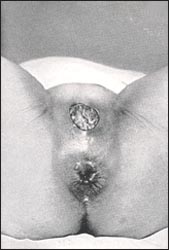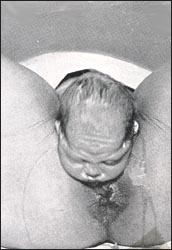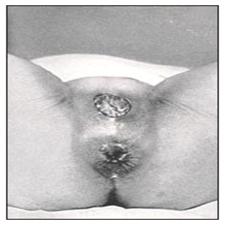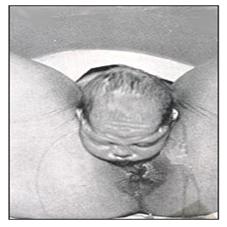

B군 연구균 감염병 Group B streptococcal infections
B군 연구균 감염병(GBS infections)의 원인, 역학
-
연쇄상구균(연구균)은 A군, B군, C군, D군, E군, F군, G군 등 여러 종류의 혈청 군종으로 분류된다.
-
여러 종류의 연구균 혈청군 종 중, 분만 전후기에 태아나 신생아가 B군 연구균에 감염되면 신생아에게 여러 종류의 B군 연구균 감염병(B군 감염병/Group B streptoccocal infections/(GBS infections))이 발병할 수 있다.
-
B군 연구균은 10가지 형으로 세분된다.
-
B군 연구균은 사람의 위장관, 비뇨 생식기에 집락형성하는 세균이고 드물게 인두에도 집락형성(Colonization)하는 세균이다. 임신 중 임신부의 비뇨 생식기에 15-35%가 집락형성되어 있다.
- 신생아에게 생기는 GBS infections는 조기에 생기는(GBS infections외 후기에 생기는 GBS infections으로 분류된다.
증상 징후
-
분만부의 질 산도를 통과해서 태어날 때 분만부의 요로와 질 산도 등에 집락형성하고 있던 B군 연구균이 산도를 통해 태어나는 아기에게 감염되면 B군 연구균 감염병이 신생아에게 생길 수 있다.
-
또 출산 전후 산모에게 B군 연구균이 감염되면 산모 B군 연구균 패혈증, 심내막염 B군 연구균 자궁 내막염, B군 연구균 요로 감염 등이 산모에게 생길 수 있고 그리고 융모 양막에 감염되면 B군 연구균 융모 양막염 등이 생길 수 있다.
-
신생아들이나 생후 3개월 이전 영아들에게 다음과 같은 침입성 B군 연구균 감염병이 생길 수 있다.
-
B군 연구균 폐렴병,
-
B군 연구균 뇌막염(수막염),
-
B군 연구균 패혈증,
-
B군 연구균 골수염,
-
B군 연구균 관절염,
-
B군 연구균 봉소염 등이 신생아들이나 영아들에게 생길 수 있다.
-
-
특히 생후 24시간 내 신생아에게 B군 연구균이 감염되면 B군 연구균 신생아 폐렴, B군 연구균 뇌막염, B군 연구균 패혈증, 뇌막염 등 조기발병 연구균 감염병이 생길 수 있고 그로 인해 호흡곤란, 저 체온증, 무 호흡증, 쇼크 등의 증상 징후가 생길 수 있다.
-
출생 후 3~4주에 후기 발병 B군 연구균 감염병-패혈증, 뇌막염, 골수염, 화농성 관절염, 괴사성 근막염, 림프절염, 폐렴, 봉소염 등이 생길 수 있다. 이런 뇌막염에서 회복된 아이들은 중추신경 이상 후유증, 뇌피질성 시력상실, 대뇌성 뇌성마비, 시력장애, 청력 감소, 학습 장애 등이 생길 수 있다.
-
당뇨병이나 만성 간질환, 신장 질환, 암, 면역 손상 등이 있는 임신하지 않은 성인들에게 B군 연구균이 감염되어 전신성 감염병이 생길 수도 있다.
-
응급 치료를 적절히 하지 않으면 대개 그로 인해 신생아나 영아가 사망하는 것이 보통이다.

사진 2-39. 질 산도를 통과해서 태어나는 아기가 산모의 피, 점액, 소변, 또는 대변 등에 접촉될 때 분만부로부터 B군 연구균에 감염되어 신생아에게 B군 연구균 감염병이 생길 수 있다
출처– 임신에서 신생아 돌보기까지와 De Lee and Greenhill: Used with permission from Principles and practice of obstetrices, W. B. Sounders

사진 2-40. 질 산도를 통과해서 태어나는 아기가 분만부의 피, 점액, 소변, 또는 대변 등에 접촉될 때 분만부로부터 B군 연구균에 감염되어 신생아에게 B군 연구균 감염병이 생길 수 있다
출처– 임신에서 신생아 돌보기까지와 De Lee and Greenhill: Used with permission from Principles and practice of obstetrices, W. B. Sounders
진단
-
병력, 증상 징후 진찰 소견을 종합해 신생아나 영아가 B군 연구균에 감염되었다고 추정하면
-
산모의 소변, 질 강에서 얻은 피검 물로 그람 염색 세균 현미경 검사 및 세균 배양검사를 하고 또 신생아의 혈액, 소변과 뇌척수 액 세균 현미경 검사와 세균 배양검사를 해서 진단한다. 그리고 필요에 따라 늑막 액, 관절 액 등으로 세균 검사해 진단한다. 뇌척수액으로 속성 항원 항체 검사로 진단한다.
치료
-
암피실린+아미노글라이코사이드항생제로 신생아 조기 발병 B군 연구균 감염병을 치료하기 시작한다.
-
후기 발병 B군 연구균 감염병-뇌막염 등은 암피실린+아미노글라이코사이드 항생제로 경험에 비춰 치료를 하거나 Cefotaxime으로 치료한다.
-
세균 항생제 민감도 검사에 따라 Penicillin이나 Ampicillin으로 치료할 수도 있다.
B군 연구균 감염병의 예방
-
임신 36~37주에 모든 임신부의 질 강, 항문과 직장 등에 B군 연구균 전이식증(Colonization)이 있는지 (보균하고 있는지)진단하기 위해 분만 전 B군 연구균 세균 검사를 통상적으로 하고 B군 연구균이 검출되면 분만 시 산모는 항생제 예방적 치료를 받으라고 미 CDC는 권장한다. 분만 전 B군 연구균 세균 검사에 임신부에게 B군 연구균 전이식증이 있으면 태어나는 신생아에게 침입성 조기 B군 연구균 세균 감염병이 생기지 않게 분만 중 산모에게 항생제를 주어 태어난 아기에게 B군 연구균 세균 감염병이 생기지 않게 예방 조치를 한다.
-
전에 태어난 신생아에게 침입성 B군 연구균 감염병이 있었으면 분만 시 산모에게도 분만중 예방적 항생제 치료(Intraprtum antibiotic prophylaxis/IAP)를 하도록 권장한다.
-
분만이 이미 시작됐을 때, 양막이 이미 파열됐을 때, 임신부의 질 강, 항문과 직장 등에 B군 연구균 전이식증이 있는지 알아보는 세균 검사 결과를 아직 모르거나, 그런 검사를 했 었는지 안 했었는지 모르고 있을 때는 산모는 분만중 예방적 항생제 치료를 받으라고 권장한다.
-
임신 37주 전, 미숙 신생아 분만이 시작하면 신생아 B군 연구균 감염병 항생제 예방 치료를 하기 위해 항생제 예방 치료를 분만부에게 시작 한다.
-
임신 중 임신부의 소변 검사에서 B군 연구균이 검출되면 분만 시 항생제 예방치료를 받아야한다.
-
B군 연구균을 보균한 모든 분만부는 항생제 예방치료를 받아야한다.
-
분만이 시작하지 안한 임신부가 제왕절개 수술분만을 받을 때는 B군 연구균 항생제 예방치료를 꼭 받을 필요가 없다.
-
페니실린에 알레르기가 없으면 페니실린으로 B군 연구균 항생제 예방치료를 하는 것이 보통이다.
-
적절한 분만 중 항생제 예방치료를 받은 산모에게 태어난 신생아에게는 기본 항생제 치료를 하지 않는 것이 보통이다.
-
패혈증의 증상이 있는 신생아는 적절한 진단 평가를 받고 경험 토대로 항생제 치료를 시작해야 한다.
-
더 자세한 B군 연구균 항생제 예방적 치료에 관해 Red Book, American Academy of Pediatrics. 30판 참조.
-
[부모도 반의사가 되어야 한다–소아가정간호백과]-제6권 신생아 성장 발육 양호 질병–신생아 뇌막염과 패혈증 (Meningitis and sepsis in newborn infants, Neonatal meningitis and sepsis), 신생아 폐렴 (Neonatal pneumonia, pneumonia of newborn, pneumonia in newborn)
Streptococcal group B infection during pregnancy 임신 중 B군 연구균 감염으로 인한 감염병

When the baby comes into contact with the mother’s blood or mucus during delivery, the mother can infect the group B research bacteria, resulting in infection of the newborn group B research bacteria. Sources-From Pregnancy to Newborn Care and De Lee and Greenhill: Principles and practice of obstetrics, W. B. Sounders
![]()

When a baby comes into contact with blood or mucus from the mother during delivery, the newborn is infected with group B research bacteria, and newborns can become infected with group B research bacteria. Sources-From Pregnancy to Newborn Care and De Lee and Greenhill: Principles and practice of obstetrices, W. B. Sounders
Streptococcus (research bacteria) is classified into several groups such as group A, group B, group C, group D, and group E.
Among them, various infectious diseases can occur in newborns due to infection of group B research bacteria.
One of them is group B study bacterial neonatal sepsis.
If group B research bacteria, which were latent in the mother’s urinary tract and birth canal, become infected with the newborn during delivery, infection with group B research bacteria may occur in the newborn.
When a mother is infected with group B research bacteria, it can lead to group B research bacteria bacteremia, endometritis, and chorionic amniotic infection. When newborns or infants older than 3 months of age are infected with group B research bacteria, serious life-threatening infections of group B bacteria such as pneumonia, meningitis, bacteremia, osteomyelitis, arthritis, and cellulitis can occur.
In particular, if a newborn baby 24 hours after birth is infected with group B research bacteria, pneumonia, meningitis, and sepsis can occur. Such infections can lead to symptoms such as difficulty breathing, hypothermia, apnea, and shock. If not treated properly, newborns or infants die.
The incubation period is about 7 days. If you suspect this disease by combining medical history, symptoms, and medical examination, blood or mucus is collected from the mother’s urine and vagina, and Gram-stained bacteria microscopic examination and bacterial culture test, and Gram-stained bacteria microscopic examination and bacterial culture with newborn blood, urine and cerebrospinal fluid Diagnosis by performing tests, etc.
Treatment is emergency treatment with penicillin or ampicillin vascular injection.
Some content is repeated.
Group B streptococcal infections
epidemiology of group B research bacteria infectious diseases (GBS infections)
Streptococcus (research bacteria) is classified into several types of serotypes, such as group A, group B, group C, group D, group E, group F, and group G. Among the various types of research bacteria serogroup species, when a fetus or newborn infant is infected with group B research bacteria in the pre-and postpartum period, the newborn develops several types of group B research bacteria infectious diseases (Group B streptococcal infections/(GBS infections)). can do. Group B research bacteria are subdivided into 10 types. Group B research bacteria are bacteria that colonize the human gastrointestinal tract and genitourinary tract and rarely colonize the pharynx. During pregnancy, 15-35% of the urogenital organs of pregnant women are colonized. GBS infections that occur in newborns are classified as GBS infections that occur early (other than GBS infections).
Symptoms signs
When group B hemolytic bacteria, which were colonized in the urinary tract and the vaginal acidity of the delivery part, were infected through the birth canal when they were born through the vaginal acidity of the delivery part, a group B research bacteria infectious disease may occur in the newborn. In addition, if the mother is infected with group B research bacteria before and after childbirth, the mother may develop group B research bacteria sepsis, endocarditis group B research bacteria endometritis, group B research bacteria urinary tract infection, etc.
It can lead to chorionic amniotic infection. The following invasive group B research bacteria infectious diseases can occur in newborns or infants older than 3 months of age.
- Group B research bacteria pneumonia,
- Group B research bacteria meningitis (meningitis),
- Group B research bacterial sepsis,
- Group B research bacteria osteomyelitis,
- Group B research bacteria arthritis,
- Group B research bacteria cellulitis,
- etc.
can occur in newborns and infants. In particular, if the newborn is infected with group B research bacteria within 24 hours of life, early-onset research bacteria infectious diseases such as group B research bacteria neonatal pneumonia, group B research bacteria meningitis, group B research bacteria sepsis, meningitis, etc. may occur.
Symptoms such as body temperature, apnea, and shock may occur. 3-4 weeks after birth, late-onset group B research bacteria infectious diseases-sepsis, meningitis, osteomyelitis, purulent arthritis, necrotizing fasciitis, lymphadenitis, pneumonia, cellulitis, etc. may occur
. Children recovering from such meningitis may develop central nervous system abnormalities, cortical vision loss, cerebral palsy, vision impairment, hearing loss, and learning disabilities.
Non-pregnant adults with diabetes, chronic liver disease, kidney disease, cancer, and immune damage may be infected with group B research bacteria, resulting in systemic infectious diseases.
Inadequate emergency care usually results in the death of a newborn or infant.

Photo 2-39. When a baby born through the vaginal acidity comes into contact with the mother’s blood, mucus, urine, or feces, it may be infected with group B research bacteria from the delivery department and cause a group B research bacteria infectious disease in newborns. Source– From pregnancy to newborn care and De Lee and Greenhill: Used with permission from Principles and practice of obstetrics, W. B. Sounders

Photo 2-40. When a baby born through the vaginal acidity comes into contact with the blood, mucus, urine, or feces of the delivery woman, it may be infected with group B research bacteria from the delivery department and cause a group B research bacteria infectious disease in newborns. Source– From pregnancy to newborn care and De Lee and Greenhill: Used with permission from Principles and practice of obstetrics, W. B. Sounders
Diagnosis
If you presume that a newborn or infant is infected with a group B research bacteria by combining the medical history, symptoms, signs, examination findings, Gram-stained bacteria microscopic examination and bacterial culture test are performed with the specimens obtained from the mother’s urine and vaginal cavity, and the diagnosis is performed by microscopic examination of the newborn baby’s blood, urine and cerebrospinal fluid, and bacterial culture. And, if necessary, conduct a bacterial test with pleural fluid, joint fluid, etc. to diagnose. It is diagnosed by the rapid antigen-antibody test with cerebrospinal fluid.
Treatment
Ampicillin + aminoglycoside antibiotics begin to treat early-onset neonatal group B bacterial infections. Late-onset group B research bacteria infectious diseases-meningitis, etc. are treated with ampicillin + aminoglycoside antibiotics based on experience or treated with Cefotaxime.
Treatment with Penicillin or Ampicillin may be possible, depending on the bacterial antibiotic sensitivity test.
Prevention of infectious diseases of group B research bacteria In order to diagnose the presence of (containing) group B research bacteria colonization in the vaginal cavity, anus, and rectum of all pregnant women at 36-37 weeks of pregnancy, a group B research bacterial test is routinely performed before delivery, and a group B study is performed.
If the fungus is detected, the CDC recommends that the mother receive antibiotic prophylactic treatment during delivery.
If a pregnant woman has group B research bacteria metastasis before delivery, antibiotics are given to the mother during delivery to prevent early invasive group B research bacteria infectious diseases in the newborn baby.
Take preventive measures to prevent infectious diseases from occurring.
If a newborn baby who was born previously had an invasive group B disease infectious disease, it is recommended that the mother also receive prophylaxis during delivery (Intraprtum antibiotic prophylaxis/IAP) during delivery. When childbirth has already begun, when the amniotic membrane has already ruptured, the results of the bacteriological test to determine if there is metastasis of group B research bacteria in the vagina, anus, and rectum of a pregnant woman are not yet known, or whether such a test has been performed or not. When present, the mother is recommended to receive prophylactic antibiotic treatment during delivery.
37 weeks before gestation, if the birth of an immature newborn baby begins, antibiotic prophylaxis treatment is initiated to the delivery department in order to prevent antibiotics from infectious diseases of group B neonates.
If group B research bacteria are detected in a pregnant woman’s urine test during pregnancy, antibiotic prophylaxis should be sought at the time of delivery. All delivery women carrying group B research bacteria should receive antibiotic prophylaxis.
When a pregnant woman who has not started delivery is receiving a cesarean section, it is not necessary to receive antibiotic prophylactic treatment for group B research bacteria.
If you are not allergic to penicillin, it is common to use penicillin to prevent antibiotics for group B research bacteria.
It is common for newborns born to mothers who received antibiotic prophylaxis during proper delivery to not receive basic antibiotic treatment.
Newborns with symptoms of sepsis should receive an appropriate diagnostic evaluation and begin antibiotic therapy based on experience. For more detailed information on the prophylactic treatment of antibiotics for group B bacteria, see Red Book, American Academy of Pediatrics. Refer to the 30th edition.
Visit www.drleepediatrics.com-Volume 6 Neonatal growth and developmental diseases–Meningitis and sepsis in newborn infants, Neonatal meningitis and sepsis, Neonatal pneumonia, pneumonia of newborn , pneumonia in newborn)
출처 및 참조문헌
- Neonatology Jeffrey J.Pomerance, C. Joan Richardson
- Nelson Textbook of Pediatrics 14-19th ed. Beherman,
- The Johns Hopkins Hospital, The Harriet Lane Handbook, 18th edition
- Red book 29th edition 2012
- Infectious disease of children, Saul Krugman, Samuel L Katz, Ann A. Gerhon, Catherine Wilfert
- Childhood Emergencies in the Office, Hospital and Community, American Academy of Pediatrics
- Emergency Medical Service for Children, By Ross Lab. May 1989. p.10
- Emergency care, Harvey grant, and Robert Murray
- Emergency Care Transportation of Sick and Injured American Academy of Orthopaedic Surgeons
- Emergency Pediatrics A Guide to Ambulatory Care, Roger M. Barkin, Peter Rosen
- Immediate care of the acutely ill and injured, Hugh E. Stephenson, Jr
- The Critically Ill Child, Diagnosis and Management, Edited by Clement A. Smith
- Emergency Medical Services for Children: The Role of the Primary Care Provider, America Academy of Pediatrics
- The Harriet Lane Handbook 19th Edition
- 소아과학 대한교과서
- 제1권 소아청소년 응급의료 참조문헌과 출처
- 제2권 소아청소년 질병․안전사고 예방 참조문헌과 출처
- 제7권 소아청소년 감염병 참조 문헌 및 출처
- AAP News 8/2019
- Other
Copyright ⓒ 2020 John Sangwon Lee, MD., FAAP
“부모도 반의사가 되어야 한다”-내용은 여러분들의 의사로부터 얻은 정보와 진료를 대신할 수 없습니다.
“The information contained in this publication should not be used as a substitute for the medical care and advice of your doctor. There may be variations in treatment that your doctor may recommend based on individual facts and circumstances.
“Parental education is the best medicine.